The textile and clothing (TC) industries are among the first industries to become internationalized, serving as a backbone for countries targeting export-oriented and labor-intensive industrialization plans [1]. In today’s world, TC industries are indispensable for developing and even developed countries due to their contribution to employment, international trade and gross national product [2]. TC industries are interrelated however, they have different phases of technological development as the textile industry requires more developed technology and is less labor intensive compared to the clothing industry [3]. Competition in the TC industries has increased worldwide since the 1990s mainly because of an increase in low-cost production in countries such as China, India, Turkey, Pakistan, and Egypt [4]. With the entrance of China into the world trade organization (WTO) in 2001 and the abolition of quotas and tariffs worldwide in 2005, the TC industries entered an era of liberalization [5].
Competitiveness is context dependent, which is relevant to all the different levels of the economy, which are company, industry and country [6]. International competitiveness is a contextual concept with two fundamental explanations: the first one is the capacity of a state to boost national income and prosperity, whereas the second one is the competitiveness of the country in international trade, mainly export and import [5,7,8]. Generally, market share (MS), trade competitiveness (TRC) and normalized revealed comparative advantage (NRCA) are common in the measurement of international competitiveness [9,10,11]. Kanat [12] analyzed the international competitiveness of TC industries of Turkey and its main rivals in the EU-28 region, but Poland was not included in her research. In other research, Halife [13] compared the international competitiveness of the Turkish TC industry with the Indian, Chinese, Vietnamese and U.S. TC industries. Altay and Gacaner [14] analysed the international competitiveness of the TC industries of Turkey and China in the developed markets of the European Union (EU) and US by taking advantage of RCA indicators.
Turkey is an important player of the TC industries in the world as it is the fourth largest textile exporting country with a share of 4.2 percent, and the seventh largest clothing exporting country with a share of 3.5 percent in 2022 [15]. The internationalization of both the Polish and Turkish TC industries follows the same path as their internationalization started gradually from the nearest developed market, which is the EU area [2]. Germany is the biggest export market for both the Polish and Turkish TC industries. Germany had a share of 13 percent in Turkish TC exports in 2022. Although the size of the Polish TC industry is relatively small compared to Turkey’s, the share of Germany was 41 percent in the Polish TC industry in 2024 [16]. Therefore, analysing the international competitiveness of Poland and Turkey’s TC industries is very important. There is a research gap in the literature in this area, and the aim of this research is to compare the international competitiveness of the Polish and Turkish TC industries and their competitiveness in Germany, which is the biggest export market for both countries.
Turkey is the nineteenth biggest economy in the world, with a population of 85 million and 906 billion USD gross national product and 10661 USD per capita, with a growth rate of 5.6 percent. The unemployment rate was 10 percent and the inflation rate on consumer goods was 72 percent for the year 2022 [16]. The Turkish TC industry is the most important of the Turkish economy in terms of employment, contribution to gross national product and foreign currency generation [17]. The Turkish textile industry was mainly reliant on imports until the 1950s, whereas the Turkish clothing industry was dependent on imports until the 1970s. However, both industries mainly served the domestic market until the 1980s. The Turkish industry had gained importance in the international markets by the 1980s as a result of liberalization in the Turkish economy and had a higher growth rate than the average of the Turkish manufacturing industry by the mid-1980s [2]. This growth was the result of an export-oriented model, which aimed to increase exports to the EU, which is the nearest developed market [18]. The Turkish government has offered incentives such as export subsidy credits, and tax exemptions on imported machinery in order to attract foreign investment. As a result of these incentives, many European companies have shifted their production to Turkey mainly because of Turkey’s location and cheaper labor force. Germany is the leader of “outward processing” in manufacturing in the EU, and in the 1980s, 35 percent of the foreign investment received by the Turkish TC industry was by German companies as a joint venture. In 1996, Turkey signed a “customs union agreement” with the EU and at least a 10 percent increase in TC exports was accepted after this agreement. Surprisingly, a 3 percent decline occurred in 1996, mainly because of the recession in the EU, limited time period to adopt the new regulations and tax imposed on textile raw materials [2]. China’s membership of the World Trade Organization in 2001 made China the biggest player in TC industries in the world, and the removal of TC quotas in 2005 affected Turkish TC industries negatively [2]. The Turkish TC industry is still trying to maintain its position despite the number of challenges, including the increasing labor and raw material costs, decreasing demand in international markets and intense competition and changes in the behaviours of consumers [19]. Turkish TC industries are clustered in certain cities; yarn production in Kahramanmaras, Istanbul, Gaziantep and Bursa; home textiles in Denizli; dyeing and finishing in Corlu and Cerkezkoy, and knitting and clothing in Istanbul. The capacity utilization rate of the Turkish textile industry is 79 percent and the clothing industry 76 percent, which is compatible with the average of the Turkish manufacturing industry, which was 76.3 percent in 2021 [15]. Turkish TC industries had an export value of 35,295,646 thousand USD in the world, Germany a share of 13.14 percent with a value 4,639,194 thousand USD followed by Spain with a share of 8.85 percent and value of 3,126,506 thousand USD in 2022 [20]. Turkey mainly imports TC from China, with a share of 20.64 percent and value of 3,246499 thousand USD. China is followed by the United States of America, with a share of 7.93 percent and value of 1,247,797 thousand USD [16].
Poland is the twenty first biggest economy in the world, with a population of 39.3 million and 697.2 billion USD gross national product and 17,740 USD per capita, with a growth rate of 4.9 percent. The unemployment rate was 2.6 percent and the inflation rate on consumer goods was 14.4 percent for the year 2022 [16]. According to a report of Euratex [21], Polish TC industries make up 11 percent of employment, 4 percent of turnover and 3 percent of the export of the EU. The TC industry is one of the most vital industries of the Polish economy [22] and one of the most important industries in Eastern and Central Europe, dating back to the 19th century. It is mainly accumulated in the Lodz region [23). The Polish TC industry consists of 31 percent of textile companies and 69 percent of clothing companies. Similarly, the structure of the European TC industry is very similar, with 33 percent being textile companies and 67 percent clothing companies [21]. The main difference is that the share of small and medium enterprises is less compared to other EU countries. In textile production, 19.9 percent of companies have an 80 percent share in the commercial value of sold production, while in clothing production 39.8 percent of companies have this 80 percent share in the value of sold production [24]. In the decade of the 1990’s, Polish TC industries had an adaptation period to a market economy, and mainly state-owned enterprises made radical changes to adapt to the systematic changes occurring in the country. Those mass changes became so widespread that it became one of the major transformations of the Polish economy [23]. In 1998, Poland TC industries had free access to the European market after the abolition of tariffs and quotas. In 2004, after the joining of Poland to the EU, as a member country Poland adopted tariffs and quotas for countries which are not members of the EU. Poland is the 8th biggest producer of clothing in the EU, with a production of 22.1 billion USD in 2018 according to data from the European Commission [25]. The Europe 2020 Strategy is introduced by EU members, which aims to improve the competitiveness of the European economy by giving priority to sustainable development by keeping high levels of employment, and the Polish TC received a lot of grants from the Europe 2020 Strategy. Polish TC industries had an export value of 14,011,102 thousand USD in the world, Germany 41,08 percent with a value of 5,755,966 thousand USD, followed by the Czech Republic, with just a share of 5.41 percent and a value of 758,701 thousand USD [16]. Germany is the most important market for the Polish TC industry because of its geographical proximity and high demand for the work and fashion wear of the market [26]. On the other hand, Polish TC industries mainly import from China, with a share of 24.19 percent and 4,447,428 thousand USD, Bangladesh with a share of 18.14 percent and value of 3,335,584 thousand USD, and Germany with a share of 9.49 percent and value of 1,744,320 thousand USD [16].
Germany is the fourth biggest economy in the world, with a population of 83 million and 4.08 trillion USD gross national product and 48,718 USD per capita, with a growth rate of 1.8 percent. The unemployment rate was 3 percent and the inflation rate on consumer goods 6.9 percent for the year 2022 [16]. The German TC industry is one of the important sectors of the German economy, with approximately 124,000 employees and 1,400 companies with a turnover of 42,512,392 thousand USD in 2021 [16]. The structure of the German TC industry is fragmented, with 95 percent of the companies being small and medium sized and around 50 percent of the companies employing less than 50 workers [27]. The German TC industry is mainly located in the federal states of Bavaria, Baden-Württemberg, North Rhine-Westphalia, Saxony and Thuringia. The German TC industry was the driving force of the German economy by introducing new technologies in the 18th and 19th centuries [28]. After World War II, the German TC faced challenges from South Europe, Asia and Africa, which have low wages, social costs and weak regulations compared to Germany. Nevertheless, beginning from the 1980s, the German TC industry transformed itself successively to become a major player in technical textiles rather than clothing and household textiles [28]. Sixty percent of the turnover of the German TC industry is from textiles and forty percent from clothing [15]. The German TC industry provides 19 percent of exports, 15 percent of turnover and 9 percent of the employment in the EU region. Germany had TC exports of 42,512,392 thousand USD, with the largest share to Poland with a 11.41 percent share and value of 4,853,849 thousand USD, followed by Austria with a 10.65 percent share and value of 4,528,657 thousand USD in 2022 [16]. Technical textiles, knitted garment fabrics, man-made fibers, and textile machinery are Germany’s most important export categories in the German TC industry and account for more than 60 percent of the TC industry sales figures [27]. Germany’s biggest import partner is China with a share of 23.23 percent and value of 14,926,632 thousand USD, followed by Bangladesh with a share of 15.51 percent and value of 9,970,714 thousand USD, and then Turkey with 10.24 percent and value of 6,578,168 thousand USD in 2022 [16].
Uppsala Theory of Internationalization is one of the theories which is widely used in explaining the internationalization process of companies [29]. The model was firstly mentioned by Johanson and Wiedersheim-Paul (1975) and developed by Johanson and Vahlne (1977) [30]. The main thesis of Uppsala Theory is that internationalization is a gradual process in which companies begin internationalization in small increments. The theory states that companies enter markets which are geographically and culturally similar. According to Uppsala Theory, knowledge is crucial, and lack of market-specific knowledge is accepted as an important barrier in internationalization [31]. Internationalization of both Polish and Turkish TC industries is concentrated in Germany as Germany is the largest developed export market because of its geographical proximity, commercial relations and cultural ties for both Poland and Turkey. Membership in the EU, customs advantages and logistical conveniences are the additional factors for Poland that stimulate exports to Germany. Similarly, the existence of the Customs Union and the EU facilities exporting to Germany. More importantly, the strong immigrant ties and the Turkish population present in Germany also have an impact on consumer preferences.
The basic and most popular entry mode of international business is accepted as “export”. In the literature, export is analyzed from either a macroeconomic or microeconomic perspective. The macroeconomic perspective relies on interpretations of international trade and aspects of the competitiveness of countries or industries in general. In contrast, the microeconomic perspective analyzes international competitiveness by relying on the organizational structure and specifications of companies [32]. Ricardo, who developed the comparative advantage theory, is the first who focused on the macroeconomic perspective, and according to him, if the ratios between the prices of goods differ from country to country before trade, one of those countries will have a comparative advantage in the production of one good and another one in the production of the other good. In that way, countries can achieve a higher level of prosperity when those countries focus more on the factors of production of that good in which they have a comparative advantage. Ricardo’s theory of comparative advantage, which is based on two countries, two goods and two factors of production, can be applied to today’s multi-dimension factor economies; but the main fact is that it is not possible to measure price rates of the times that countries were self-sufficient [5]. Therefore, in today’s international business, instead of comparative advantage, revealed compared advantage is used. In addition to RCA, two important indicators of international competitiveness i.e. market share (MS) and trade competitiveness (TRC) are also important in calculating the competitiveness of TC industries, like the study of Guan et al., [5].
Market share is the ratio of an export of a product in a specified country to the world’s export of that product. Market share shows the country’s share of the world market and it is an indicator of the competitiveness of a certain product. The calculation of market share is as follows:
In Formula (1), Xab represents the export value of product b of country A, and Xwb represents the world’s export value of product b. Market share is a very direct index that reflects the stage of an industry’s competitiveness in the international markets. The greater the value is, the stronger the industry’s international competitiveness is [5]. The world share of the Polish and Turkish TC industries is compared for the years 2018 and 2022 in Figure 1, which is created from data from the World Bank. The world share of TC exports of Poland ranges between 0.1 and 0.2, with an increasing trend, while nearly half of the TC export share of Turkey ranges between 0.3 and 0.4. The Polish TC industry showed positive progress until 2020 and stayed stable between years 2020 and 2022. On the other hand, there is no increase in the market share of the Turkish TC industry, and it remained stable between the years 2018 and 2022.

World market share of Polish & Turkish TC Industries (created by the author with data from the World Bank)
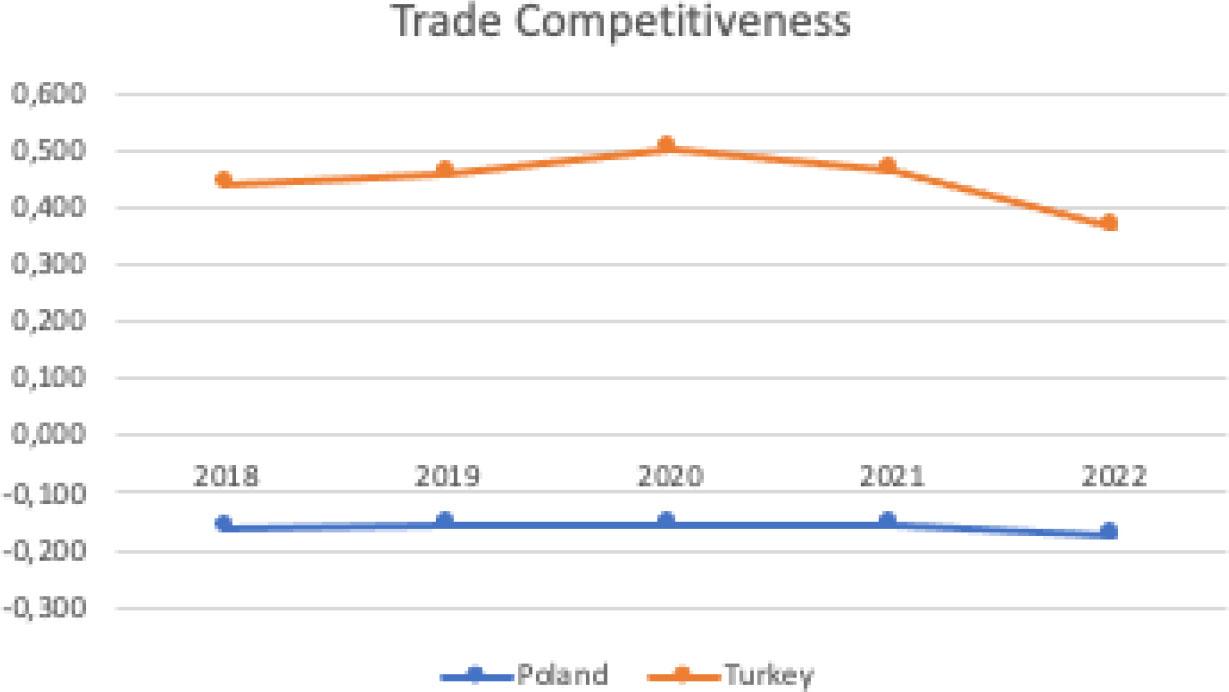
Trade Competitiveness of Polish & Turkish TC Industries (created by the author with data from the World Bank)
Trade competitiveness (TRC) is calculated by dividing the balance of trade by the total trade. The balance of trade is also named as net export and calculated by deducting total imports from total exports. Trade competitiveness is the indicator of a country’s foreign trade, formula for which is as below;
In the formula (2), TRC is the trade competitiveness indicator; a represents the product and b the country. Eab and Iab are symbols for the export and import quantities. The TRC indicator ranges from −1 to 1. If 0.8 <TRC< 1, it shows that the product has a distinguished competitive advantage. If 0.5 <TRC< 0.8, the product has a relatively high competitive advantage. If 0 <TRC< 0.5, the product has no clear competitive advantage. If the number is close to 1, the product becomes more competitive, and if it is close to 0, the product is competitive on average [5].
The trade competitiveness of the Polish TC industry has a negative value, which ranges between −0,16 and −0,17 between the years 2018 and 2022. On the other hand, the trade competitiveness of the Turkish TC industry has a positive value, ranging between 0.44 in 2018 and 0.37 in 2022. The Turkish TC industries had the highest value of 0.50 in 2020.
Ricardo was the first who tried to explain international competitiveness with the “Theory of Comparative Advantages”, followed by Heckscher-Ohlin with the “Factor Endowment Theory”. But according to both theories, measuring comparative advantage is difficult as the relative prices before the transactions are not clear. Balassa (1965) stated that the comparative advantage, which is a key concept in explaining the source of trade, can be explained by post-trade data. A method that aimed to evaluate the relative export performance of countries in certain products was first mentioned by Liesner and developed by Balassa [33].
Revealed competitive advantage (RCA) is the indicator used for measuring the advantage or disadvantage of a specific country in specific goods or services. RCA is calculated by dividing the share of exports of a product by the world exports share of the same product [5]. The Normalized Revealed Comparative Advantage (NCRA) index was developed to address and overcome the limitations of the RCA indicator. As RCA has limited ability to compare countries and products, it gives biased results for smaller economies and commodities. In addition, asymmetry in structure makes it not suitable for analyzing changes in time. NCRA is a more reliable method compared to RCA as it has consistency, symmetric distribution and comparison across time [34]. The NRCA formula (3) is following:
In Formula 3, NCRAab stands for the competitiveness of product a for country b, Eab represents the exports of products a of country b; Ea* is the total export value of all products by country a; Eb represents the total export volume of product b globally and E is the world exports of all products worldwide. (Eab/E) indicates the country’s export share of a product relative to global trade. ((Ea* Eb)/E2) stands for the expected export share of a country in a neutral comparative-advantage situation in a scenario without advantage or disadvantage. If the value of NRCA>0, it shows that product a has export competitiveness, while if RCA< 0, the product has no export competitiveness [30].
The TC exports of Poland to Germany increased from 4,581,950 USD in 2018 to 5,876,267 USD in 2022. The increase was continuous over the years, but a sharp increase occurred from 2020 to 2021 from 5,653,835 USD to 7,011,398 USD, which meant an increase of 24 percent in a year. There is a sharp decline of Poland’s exports to Germany in 2022 to 5,876,267 USD. It should be noted that the TC exports of Poland to Germany was lower than Turkey’s until 2018, but afterwards Poland’s TC exports to Germany became higher in value than Turkey’s. Figure 4 shows a comparison of exports of Polish and Turkish TC industries to the German market.
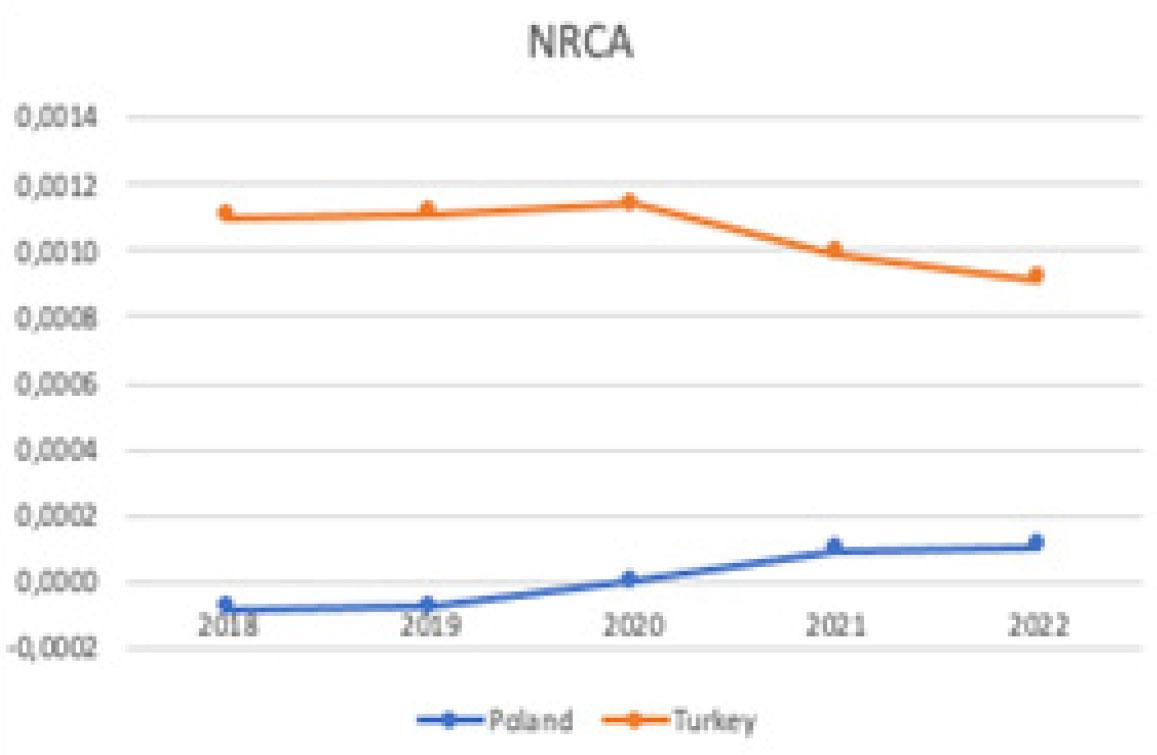
NRCA of Polish & Turkish TC Industries (created by the author with data from the World Bank)
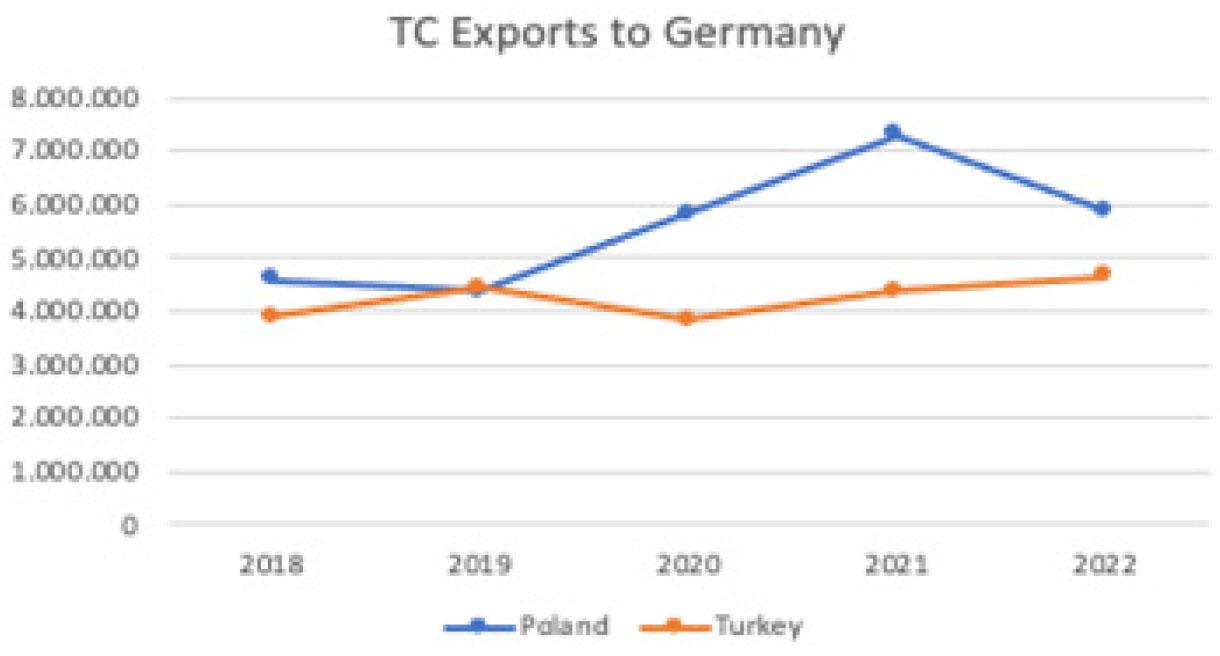
Exports of Polish & Turkish TC Industries to Germany (created by the author with data from the World Bank)
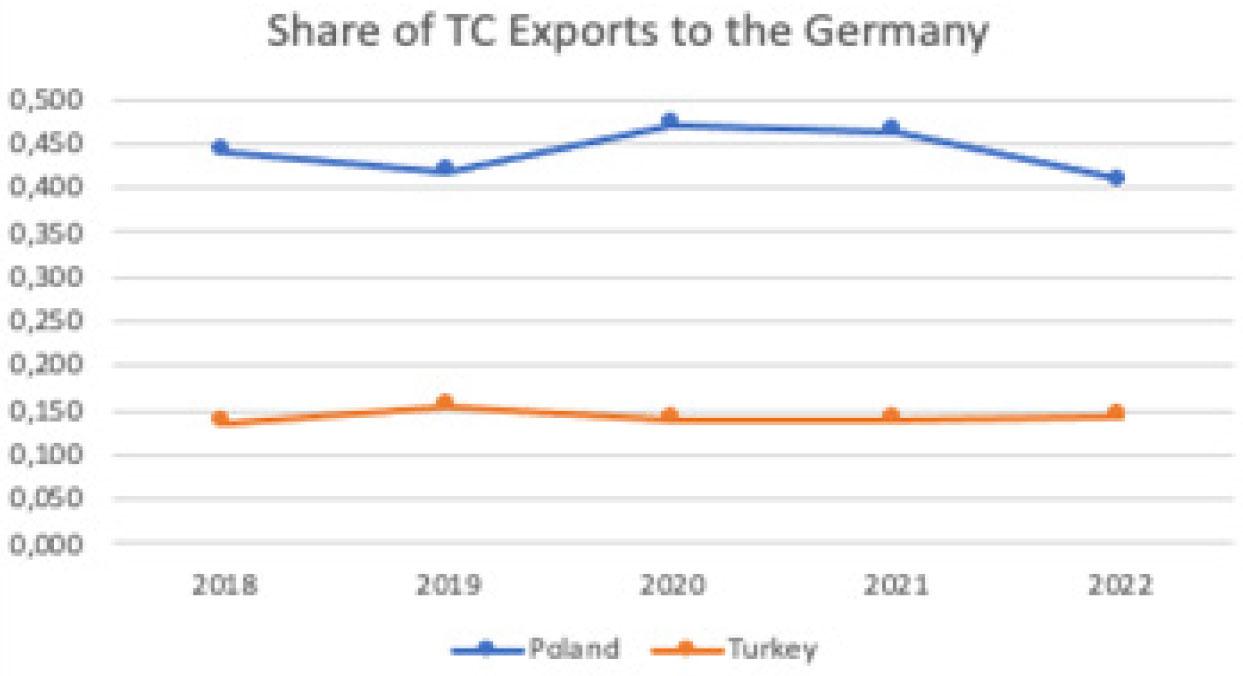
Share of Polish & Turkish TC exports to Germany (created by the author with data from the World Bank)
When we analyze the share of Polish TC exports to Germany, it ranges between 0.44 percent in 2018 and 0.41 percent in 2022. This means that Poland’s TC exports are highly concentrated on the German market with nearly half of the Polish TC exports. On the other hand, Germany is the biggest export market for the Turkish TC industry, stable at around 14 percent between the years 2018 and 2022.
The international harmonized system commodity classification (HS) of textile and clothing exports is grouped into 14 categories, where 61 and 62 are HS codes for clothing, whereas HS codes 50, 51, 52, 53, 54, 55, 56, 57, 58, 59, 60 and 63 are for textiles. Data of this part were obtained from UN Comtrade, which was developed by the World Bank. Table 1 shows the structure of Polish TC exports to Germany according to HS code classification. Customs codes 61 and 62, which are HS codes for clothing, comprise 81.24 percent of Polish TC exports to Germany in 2022. The textile categories’ HS codes make just 8 percent of the exports of Polish TC to Germany. The HS61, which is “articles of apparel accessories; knitted or crocheted”, has the largest share with 41.56 percent followed by HS62, which is the “articles of apparel accessories; not knitted or crocheted”, with 39.68 percent share, which underlines that the Polish clothing industry has a competitive advantage in “knitted or crocheted apparel articles”.
Exports of the Polish Textile & Clothing Industry to Germany (2022), Formulated by the World Bank
| POLAND’S EXPORTS TO GERMANY (2022) | USD Thousand | Germany Share (%) | Ranked | World Share (%) |
|---|---|---|---|---|
| 50 Silk | not ranked in 5 | |||
| 51 Wool, animal hair, horsehair yarn and fabric | 19351 | 22,60 | 2 | 0,16 |
| 52 Cotton | 6359 | 7,26 | 5 | 0,01 |
| 53 Vegetable textile fibres, paper yarn, woven fabric | 6355 | 10,55 | 3 | 0,10 |
| 54 Man Made filaments | 66154 | 19,57 | 1 | 0,11 |
| 55 Man Made staple fibres | 29618 | 21,55 | 1 | 0,08 |
| 56 Wadding, felt, nonwovens, yarns, twine, cordage | 105187 | 17,65 | 1 | 0,34 |
| 57 Carpets and other textile floor coverings | 57166 | 34,51 | 1 | 0,34 |
| 58 Special woven or tufted fabric, lace, tapestry | 17517 | 24,54 | 1 | 0,13 |
| 59 Impregnated, coated or laminated textile fabric | 118553 | 26,93 | 1 | 0,41 |
| 60 Knitted or crocheted fabric | 25641 | 13,42 | 1 | 0,06 |
| 61 Articles of apparel, accessories, knitted or crocheted | 2392054 | 44,58 | 1 | 0,81 |
| 62 Articles of apparel, accessories, not knitted or crocheted | 2283665 | 48,62 | 1 | 0,88 |
| 63 Other made textile articles, sets, worn clothing | 627947 | 35,49 | 1 | 0,74 |
| Total | 5755567 |
Table 2 shows the export structure of the Turkish TC to Germany and, like the Polish TC industry, HS codes 61 and 62, which show the exports of the clothing industry, make up the majority of exports of the Turkish TC to Germany, which is 87.89 percent. In contrast to the Polish clothing industry, the share of HS 61 is 50.99 percent and that of HS 62 is just 27.89 percent, which clearly indicates that the Turkish clothing industry has a competitive advantage in “not knitted or crocheted apparel articles”. The share of textile exports is 9 percent, and HS code 52 and 57 are the categories that have the highest shares in Turkish textile exports to Germany.
Exports of the Turkish Textile & Clothing Industry to Germany (2022), Formulated by the World Bank
| TURKEY’S EXPORTS TO GERMANY (2022) | USD Thousand | Germany’s Share (%) | Ranked | World Share (%) |
|---|---|---|---|---|
| 50 Silk | 110 | 6,62 | 4 | 0,01 |
| 51 Wool, animal hair, horsehair yarn and fabric | 11068 | 12,48 | 1 | 0,09 |
| 52 Cotton | 143147 | 6,32 | 5 | 0,23 |
| 53 Vegetable textile fibres, paper yarn, woven fabric | 4282 | 6,52 | 5 | 0,07 |
| 54 Man Made filaments | not ranked in 5 | |||
| 55 Man Made staple fibres | 101863 | 6,68 | 4 | 0,27 |
| 56 Wadding, felt, nonwovens, yarns, twine, cordage | 79708 | 7,07 | 3 | 0,26 |
| 57 Carpets and other textile floor coverings | 134614 | 4,77 | 4 | 0,79 |
| 58 Special woven or tufted fabric, lace, tapestry | 24498 | 5,52 | 5 | 0,19 |
| 59 Impregnated, coated or laminated textile fabric | 20110 | 5,99 | 5 | 0,07 |
| 60 Knitted or crocheted fabric | not ranked in 5 | |||
| 61 Articles of apparel, accessories, knitted or crocheted | 2219384 | 20.16 | 1 | 0.75 |
| 62 Articles of apparel, accessories, not knitted or crocheted | 1213548 | 14,34 | 2 | 0,47 |
| 63 Other made textile articles, sets, worn clothing | 528391 | 19,06 | 1 | 0,62 |
| Total | 4351923 |
The Polish and Turkish TC industries are strong in HS codes 61 (Articles of apparel, accessories, knitted or crocheted) and 62 (Articles of apparel, accessories not knitted or crocheted). The NCRA of subcodes HS 61 and HS 62 was analyzed to find out the most competitive sub-codes for the years 2018 and 2022. As mentioned above; if the value of NRCA>0, product a has international competitiveness and if NRCA<0, product a has no international competitiveness [30]. The NRCA of HS 6100 of Poland’s TC industry is calculated as 0,00161 in 2021, with a sharp increase compared to the NRCA of 0,00050 in 2020. The NCRA of the Polish TC was calculated as 0,00171 in 2022. Figure 6 shows the NRCA of Poland’s HS 61 for the years 2018 and 2022.
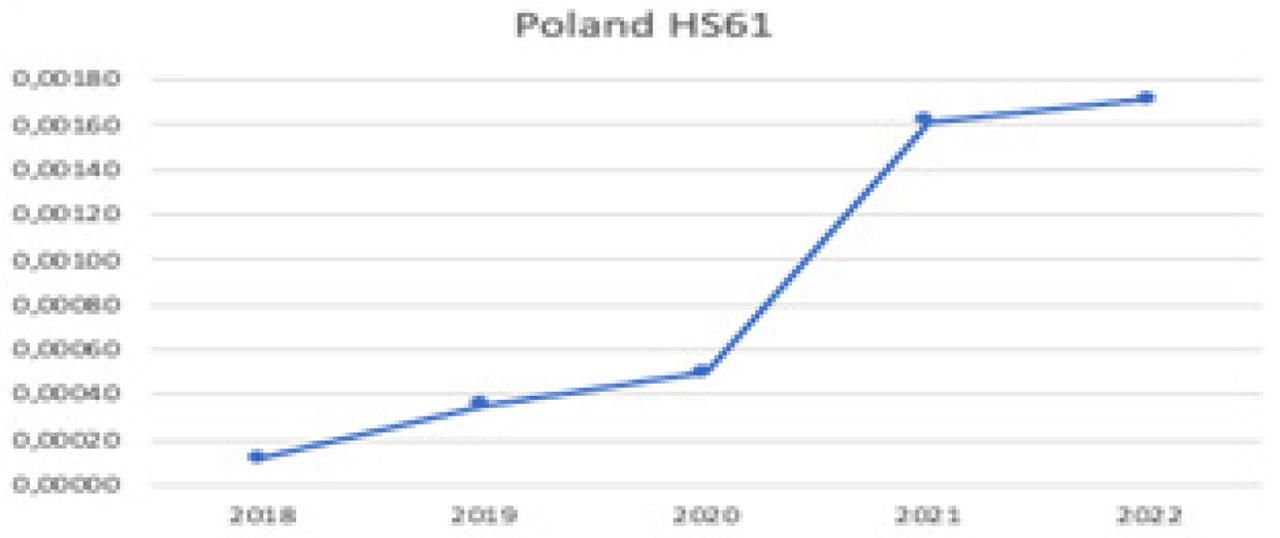
Poland’s HS61 NRCA in the world (created by the author with data from the World Bank)
Figure 7 shows the international competitiveness (NRCA) of the Polish TC industry in HS 61 by sub-codes for the years 2018 and 2022. Sub-codes 6104 (women’s suits, dresses, skirts, shorts, knitted or crocheted) with NRCA 0,00331, 6109 (t-shirts, singlets and other vests, knitted or crocheted) with NRCA 0,00318 and 6110 (jerseys, pullovers, cardigans, knitted or crocheted) with NRCA 0,00844 are the codes in HS 61 that the Polish TC industry has the highest international competitiveness in. Poland’s TC industry does not have international competitiveness in sub-codes 6101 (men’s overcoats, capes knitted or crocheted), 6106 (women’s blouses, shirts, knitted or crocheted), 6113 (garments made up of knitted or crocheted fabric) and 6115 (panty hose, tights, stockings & other hosiery, knitted or crocheted). It should be noted that in 6106 and 6115, the Polish TC industry had international competitiveness; but it lost it in 2022.
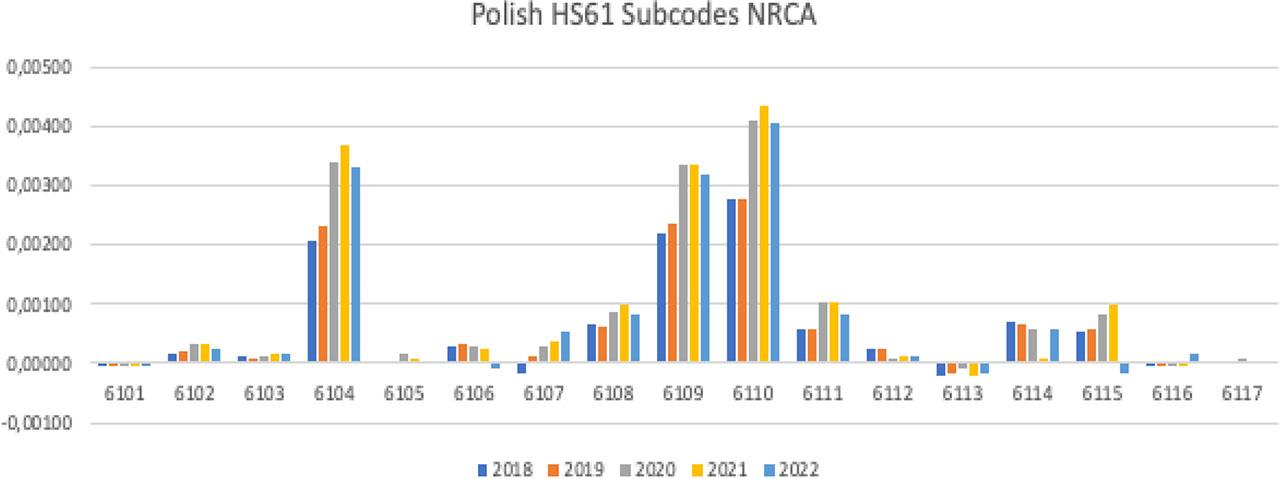
Poland’s HS61 NRCA in detail in the world (created by the author with data from the World Bank)
The NRCA of HS 6200 of Poland’s TC industry is calculated as 0,00097 in 2022, with a sharp decline compared to an NRCA of 0,00211 in 2021. Figure 8 shows the NRCA of Poland’s HS62 for the years 2018 and 2022.
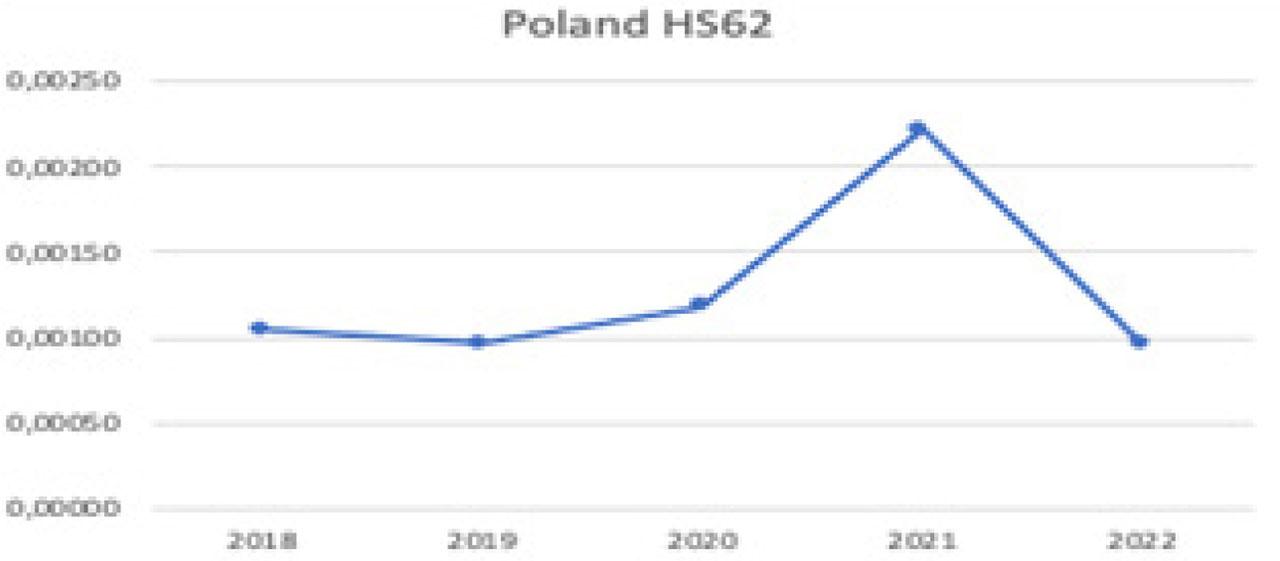
Poland’s HS62 NRCA in the world (created by the author with data from the World Bank)
Figure 9 shows the international competitiveness (NRCA) of the Polish TC industry in HS 61 by sub-codes for the years 2018 and 2022. Sub-codes 6204 (women’s suits, jackets, dresses skirts, shorts), with the highest NRCA of 0,00666, and 6202 (women’s overcoats, capes, wind-jackets), with an NRCA of 0,00200, are the most competitive ones in HS62. Codes 6205 (men’s shirts), 6211 (track suits, ski suits and swimwear), and 6212 (brassieres, girdles, corsets, braces, suspenders) also have very low international competitiveness. In addition, sub-code 6201 (men’s overcoats, capes, wind jackets) had competitiveness only in 2022 and 6203 (men’s suits, jackets, trousers, shorts) from 2020.
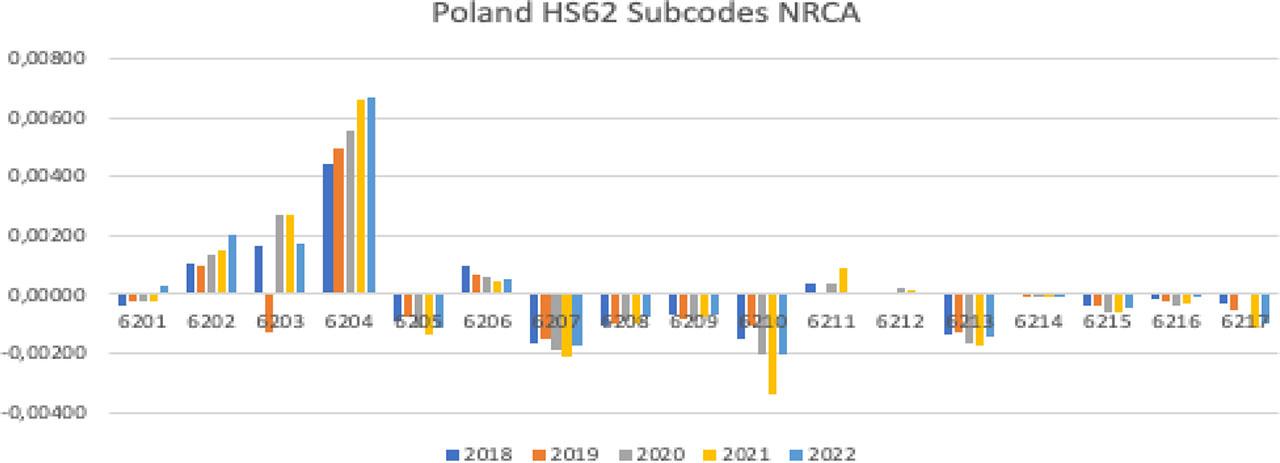
Poland’s HS62 NRCA in detail in the world ((created by the author with data from the World Bank)
Since 2018, the NRCA of the Turkish TC industry declined only in 2020, to 0,20479. Beginning from 2021, the NRCA began to increase and reached 0,28632 in 2022. Figure 10 shows the NRCA of Turkish HS61 between 2018 and 2022.
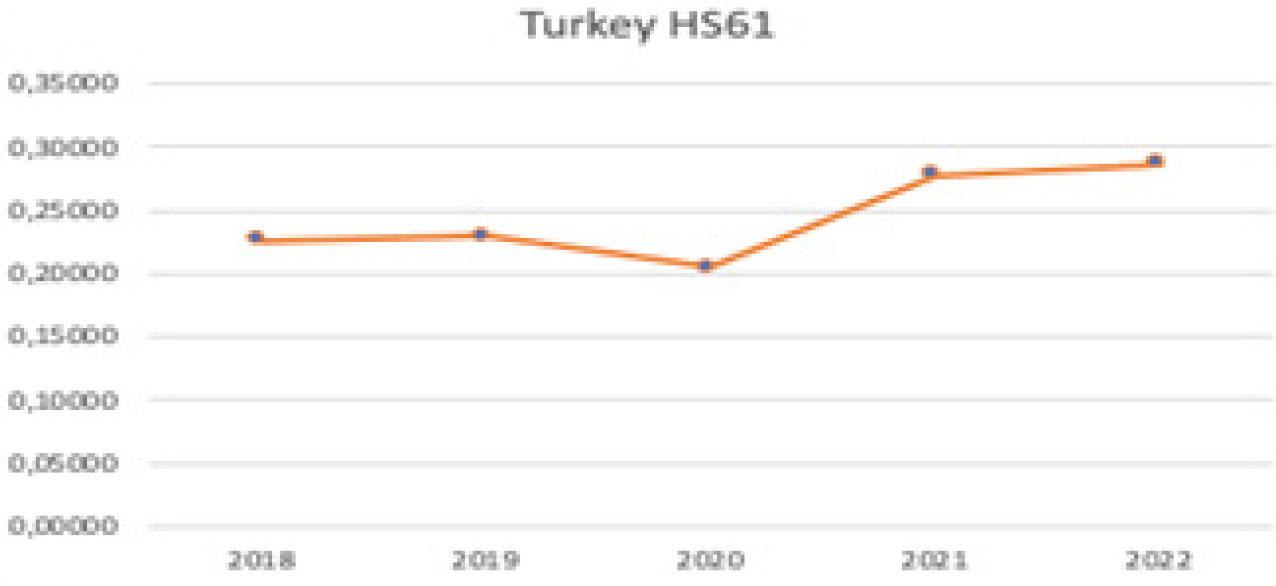
Turkish HS61 NRCA in the world (created by the author with data from the World Bank)
Figure 11 shows the international competitiveness of sub-codes of the Turkish HS61 code according to NRCA for the years 2018 and 2022. Sub-codes 6109 (t-shirts, singlets and other vests, knitted or crocheted), with 0,00913, and 6110 (jerseys, pullovers, cardigans, knitted or crocheted), with 0,00844, have the highest international competitiveness according to NRCA. Sub-codes 6101 (men’s overcoats, capes, knitted or crocheted), 6102 (women’s overcoat, cape, knitted or crocheted), 6107 (men’s underpants, pyjamas, bathrobes, knitted or crocheted), 6113 (garments knitted or crocheted), and 6116 (gloves, mittens, mitts, knitted or crocheted) do not have international competitiveness, with their negative NRCA.
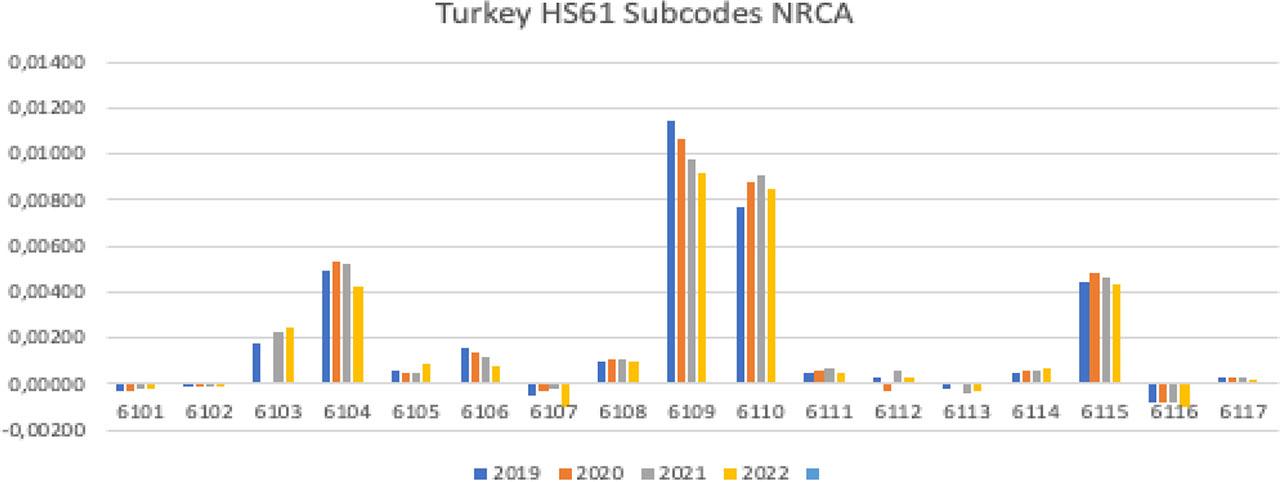
Turkish HS61 NRCA in detail in the world (created by the author with data from the World Bank)
The NRCA of code HS62 of the Turkish TC industry rose to 0,28632 in 2022 compared to 0,22577 in 2018. Figure 12 shows the NRCA of Turkish HS62 for the years 2018 and 2022.

Turkish HS62 NRCA in the world (created by the author with data from the World Bank)
Figure 13 shows the international competitiveness of sub-codes of the Turkish TC industry according to NRCA. for the years 2018 and 2022. Sub-codes 6209 (babies’ garments and clothing accessories), with an NRCA of 0,00910, and 6210, (garments made up of fabric of heading no 56.02, 56.03, 59.03, 59.06, 59.07), with an NRCA of 0,00840,in 2022 are the codes that have the highest international competitiveness in HS62. Sub-codes 6201 (men’s overcoats, capes, wind jackets), 6202 (women’s overcoats, capes, wind jackets), 6207 (men’s singlets, briefs, pyjamas, bathrobes), 6213 (handkerchiefs) and 6216 (gloves, mittens and mitts) do not have international competitiveness with their negative NRCA.
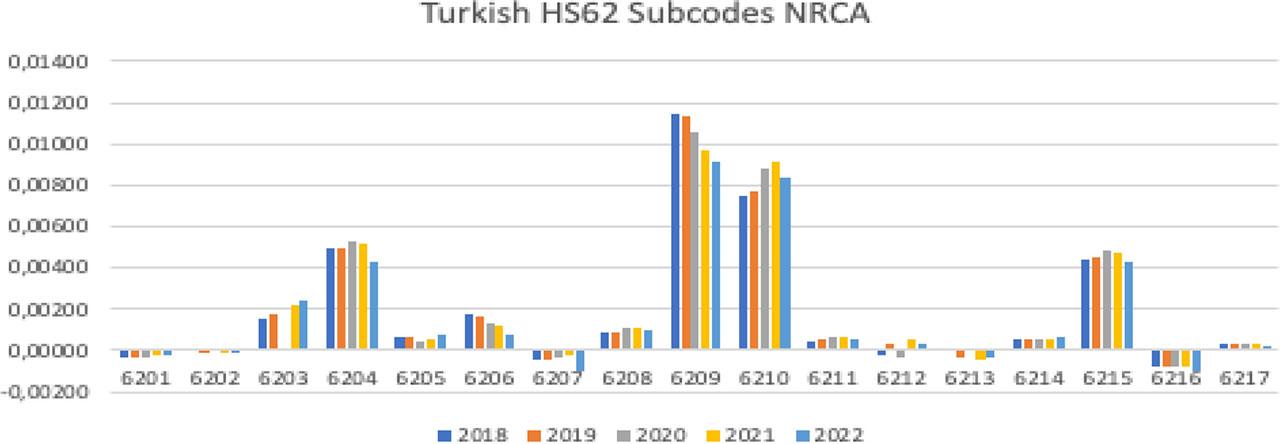
Turkish HS62 NRCA in detail in the world (created by the author with data from the World Bank)
This research is the first conducted for comparing the competitiveness of Polish and Turkish TC industries in the German market, which has the highest export figures for both industries. The majority of the exports of the Polish and Turkish TC industries are from the HS61 and HS62 codes, which belong to the clothing industry, requiring low technology. The HS61 of the Turkish TC industry has a stronger competitive advantage than that of the Polish TC industry. However, the NRCA of the Polish HS61 is more stable between the years 2018 and 2022 compared to the Turkish HS61, which had a sharp decline in 2020, but quickly recovered in 2021. Figure 14 shows the NRCA of HS61 for the Polish and Turkish TC industries. In HS61, where the volume of the exports of Poland’s TC industry to Germany is 2,392,055 thousand USD, with a share of 44.58 percent, whereas Turkey had 2,219,383 thousand USD with a share of 20.16 percent in 2022.

HS61 NRCA comparison in the world (created by the author with data from the World Bank)
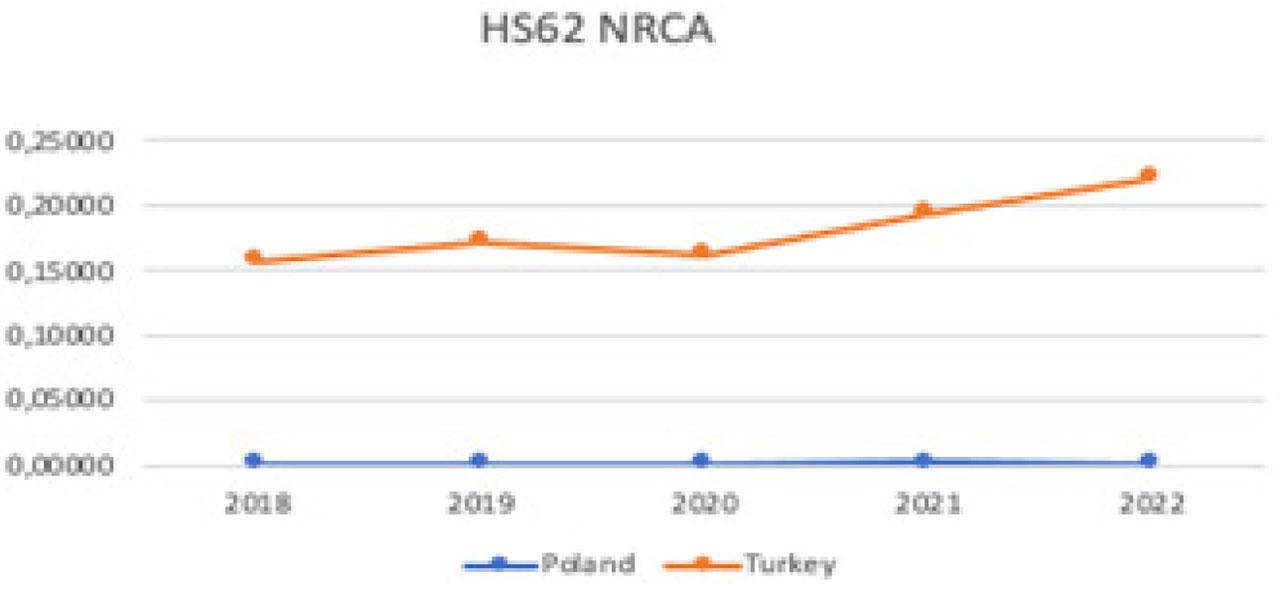
HS62 NRCA comparison in the world (created by the author with data from the World Bank)
The Polish TC industry had an export of 2,283,665 thousand USD to Germany with a share of 48.62 percent in the HS62 code, whereas the Turkish TC industry had an export of 1,213,548 thousand USD to Germany, with a share of 14.34 İN 2022. However, the Turkish TC industry has a strong NRCA in HS62 compared to the Polish TC industry, which can be seen below in Graph 15; the Polish TC industry exported nearly twice more than the Turkish TC industry.
The Polish TC industry has the highest RCA in 6202 (women’s overcoats, capes, wind jackets) and 6204 (women’s suits, jackets, dresses, skirts, shorts) under HS62. Figures 16 and 17 show the NRCA of those codes for both the Polish and Turkish TC industries in the world. It is clearly seen that Poland has strong competitiveness against Turkey in HS6202 and increased its competitiveness against Turkey in HS6204 after 2020.
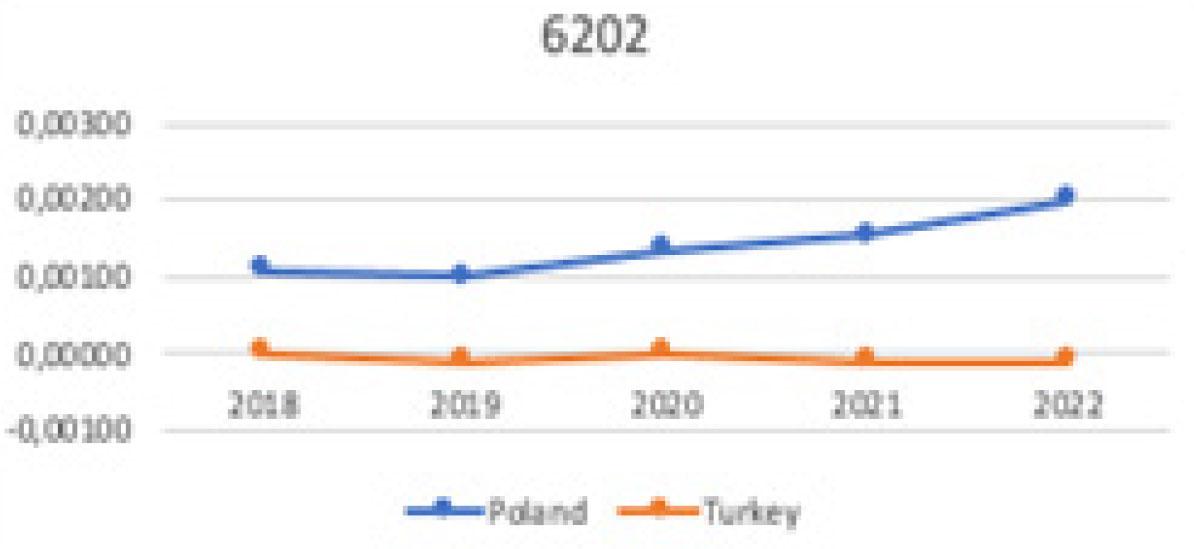
Comparison of HS6202 in the world
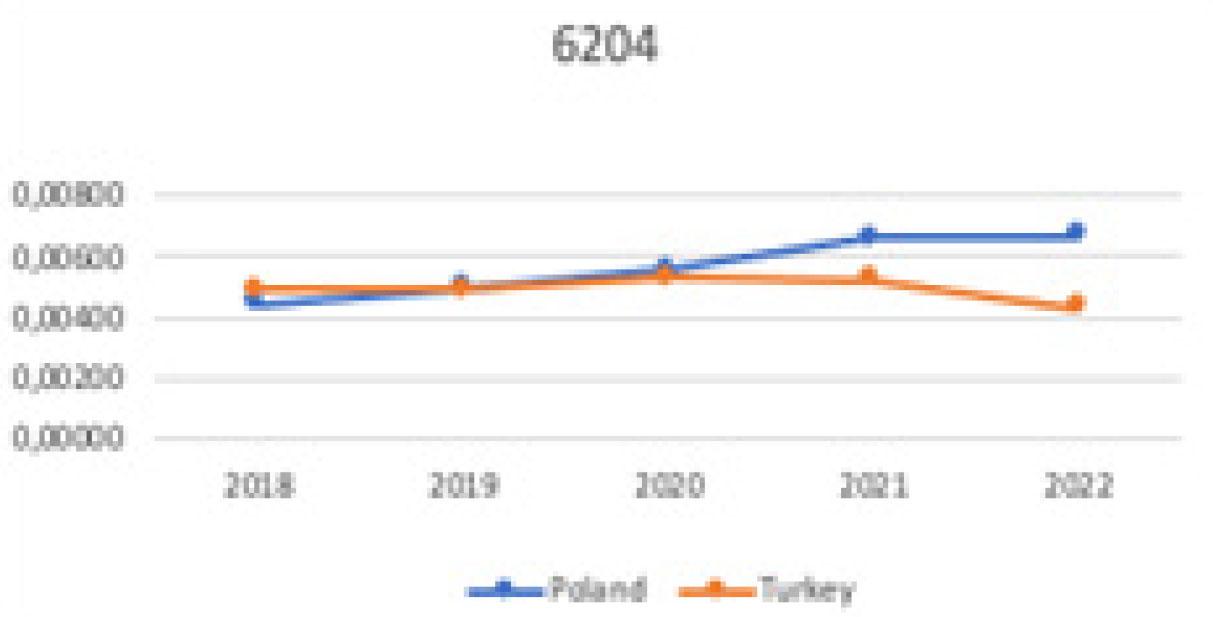
Comparison of HS6204 in the world
The Turkish TC industry has the strongest international competitiveness in HS6209 and HS6210 under HS62 in the world. Figures 18 and 19 show the NRCA of Polish and Turkish TC industries in those codes for the years 2018 and 2022.

Comparison of HS6209 in the world
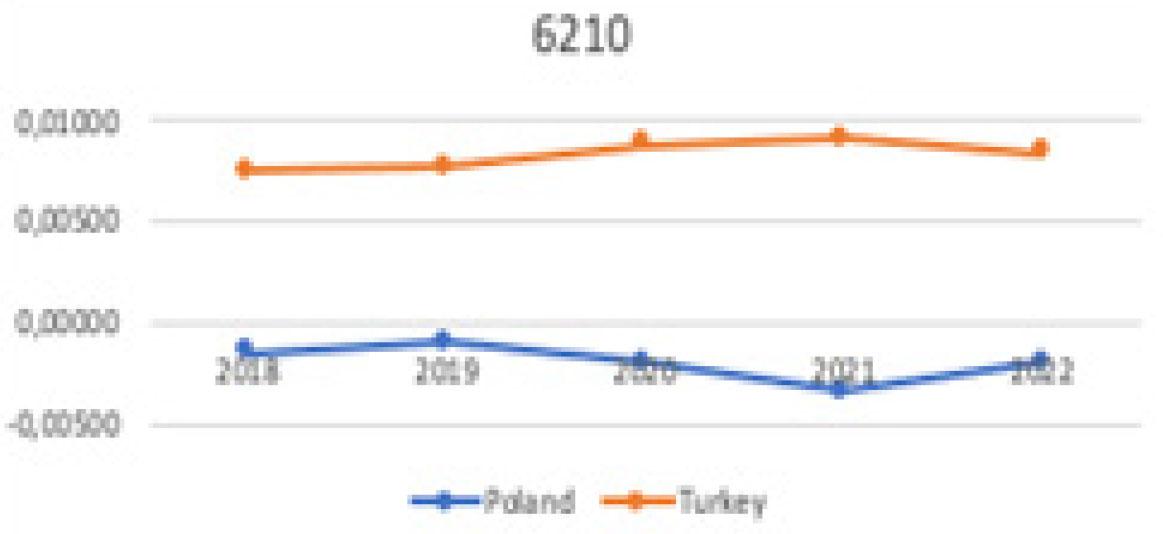
Comparison of HS6210 in the world
The TC industry has a higher share in the exports of the Turkish economy with 19 percent in 2021 whereas it is just around 3 percent of the Polish economy, which clearly underlines the importance of the TC industry to the Turkish economy [16].
Although the trade competitiveness, market share and normalized revealed competitive advantage of the Polish TC industry is much lower than the Turkish TC industry, surprisingly the value of exports of the Polish TC industry to Germany has been higher than the Turkish TC industry since 2018. It is very clear that the Turkish TC industry is facing intense competition from Poland in its biggest export market i.e. Germany. Even though there has been a decrease in the exports of the Polish TC industry to Germany, it is still higher than Turkish TC exports. The Polish TC industry has a concentration on HS61 with 41.56 percent, followed by HS62 with a share of 39.68 percent, which makes 81.24 percent in total. The export shares of HS61 and HS62 codes are 50.99 and 27.88 percent, respectively, for the Turkish TC industry, making a total of 78.87 percent, which is still accepted as over concentrated. The TC industry is accepted as a low-technology industry, with NACE codes of 17–19 by OECD [35]. Therefore, the concentration on clothing of Polish and Turkish TC industries is clearly a sign of low-technology focus.
The Polish TC industry passed through different phases of restructuring described as “the fall of a giant, vestigial existence, and rejuvenation” by Stępień and Młody [36]. The integration of the Central and East European countries into the EU, the gradual elimination of the GATT in 2005, the economic crisis at the beginning of the new millennium [36], the recent Covid-19 pandemic, the war in Ukraine and the sharp increase in fuel prices [37] are the milestones of the Polish TC industry. The Polish TC industry has made significant progress in economic stability and technological upgrade, such as automation, computerization and modern production technologies in the last decade [38]. Although the Covid-19 pandemic caused disruptions in the global supply chains, it had a positive effect on the Polish TC exports to Germany. The main reason behind this is that German companies shifted their orders to Poland due to the disruption of the supply chain in the Far East. The reason for the switch was the Polish TC industry’s ability to deliver in small quantities and make faster shipments. Secondly, the beginning of the Ukraine war negatively affected the Polish TC industry, as Ukrainian companies were used as a base for sewing because of the relatively low costs compared to Poland [38]. The Polish TC industry had to switch to Polish sewing companies, which increased the costs of the industry. Unfortunately, the energy prices began to increase rapidly from the second half of 2021 and reached the highest levels in 2022 with the Ukraine war. This increase in fuel and energy prices caused an increase in transport prices, materials, packaging, labour and inflation in the Polish TC industry. Unfortunately, the rise in the unit prices of TC products lowered the exports of the Polish TC industry to Germany [39]. On the other hand, the increasing awareness of sustainability among both governmental bodies and consumers in the EU is the most recent development for the Polish TC industry. The Polish TC industry is seriously trying to upgrade to higher value added products, mainly to technical and sustainable textiles and new sewing markets like the automotive industry [26]. The Polish TC industry is mainly investing in the areas of biotechnology, nanotechnology, information and mechatronics technologies. The transformation of the Polish TC industry mainly involves developing natural and synthetic materials through sustainable, environmentally friendly products [40].
The Turkish TC industry’s position in the international markets can be enhanced by focusing on its strengths, such as the availability and affordability of a workforce, surplus of raw materials and geographical proximity [13]. Similar to the Polish TC industry, the Turkish TC industry is in a similar situation with an over-concentration on the clothing HS codes and does not have any competitiveness in areas such as technical textiles, which requires high technology and innovation. The Turkish TC industry also has weakness in economic indicators, energy costs, imported raw materials and intense competition from Far East countries [2]. In addition, the awareness of sustainability is low in Turkey’s society and market compared to the EU. Just the regulations and standards of international customers are the main drivers of the sustainable development of the Turkish TC industry [41]. In the Turkish government’s development plan, the targets for the TC industry are branding, digitalization of the supply chain, industry 4.0, and the production of high value-added products [42]. The main question of this research: how can Poland’s TC industries be more competitive than Turkey’s just in the German market? can be explained by the “Uppsala Theory of Internationalization”, which mainly states that internationalization takes place beginning from the nearest market which has a similar culture and values. Poland’s TC industry has increased its competitive advantage against Turkey’s in the German market by its geographical proximity to Germany and the trade advantages as a member of the EU. Turkey, on the other hand, is dealing with rising input costs, complexities in EU standards’ compliance, and the neglect of sustainability trends in the production chain, which have resulted in it losing its competitiveness.
The results of this research identify key strategic areas of management attention to improve competitiveness in the German market. The Turkish TC industry needs to invest in technical and sustainable textiles instead of low technology clothing. The Polish TC industry should focus more on building their strength in clothing exports to Germany by enhancing brand recognition and expanding the market reach in the Central and Eastern European countries. Both Polish and Turkish TC industries should embrace digitalization and sustainability to address the changing consumer trends and standards.
Future research should be conducted to see how the top five biggest exporters to Germany are competing with each other.